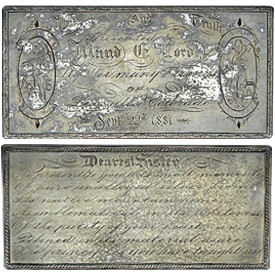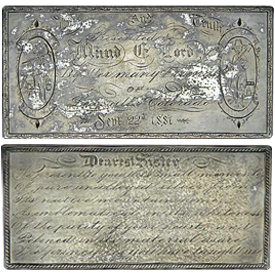This listing departs our normal assayers and refiners. Maud Drake, nee Lord, was not an assayer, refiner, or engraver. She was a noted American medium and spiritualist of the late 19th century, active in New York City, Boston, and Leadville. The unique bar shown under this listing is attribute to Maud E. Lord-Drake due to the fact that her name appears on the bar, and that the bar is void of a maker's name or mark.
Maud Lord was born in 1852 in Marion County, West Virginia. Her biographical sketch composed for Hartmann’s Who’s Who in Occultism...(1927) describes her as “Active working medium for 65 years; full-form visible materializations in daylight; independent music from guitar carried around the room near the ceiling by spirit musicians; independent voices and singing; inspirational lectures and tests, and prophecies; Clairvoyant, Clairaudient and Psychometrist. Gave two readings to Queen Victoria in Buckingham Palace. At the age of 24, spirits christened her the ‘Daughter of the Orient’ because her marvelous endowments were equal to the psychic powers possessed by the medium at the Temple of Delphi 4,000 years ago. John Slater recently said, 'In her day, Maud was Queen of them all. Her name alone was sufficient to pack the largest building anywhere.”
Mrs. Lord-Drake, a friend to Madame Helena Blavatsky and Colonel H.S. Olcott in whose rooms known as “The Lamasery” she conducted seances, disappeared from Boston on May 1, 1879 while on her way to Brockton, Massachusetts by train to hold a spirit gathering. Her sudden and unexpected absence raised alarms leading to police investigations and newspaper speculations, all of which only added to the mystery surrounding one who could speak to the dead. Two years later, Mrs. Lord-Drake was actively pursuing the Other World in Leadville, Colorado, where this ingot honoring her departure was made. She shared the Leadville public’s attention with Baby Doe, later of wider Matchless Mine fame. On Lord-Drake’s return east she resumed her career but this was not to last long before it received the sort of scrutiny she must have found unwelcome. In 1885 she was investigated by the Seybert Commission, established by the University of Pennsylvania to look into claims of spiritualism following a bequest by Henry Seybert. Descriptions of the seances held by Lord-Drake under somewhat controlled conditions in February of that year were published by the Commission in 1887 and led to some public skepticism of her claims. In 1891 Lord-Drake claimed she had helped set up Stanford University by suggesting that Leland Stanford’s dead son told his parents in one of her seances that he wanted a university founded in his name. In 1892 Mr. & Mrs. Leland Stanford publicly stated that they had decided to found the university nearly six months before they had first met Mrs. Lord-Drake and had their first seance with her. The Stanfords also stated that in their opinion Lord-Drake had been exposed as a fraud in 1892. To vindicate herself, Lord-Drake published her memoirs in 1904 but the heyday of American spiritualism had passed and with it, her fame. She died in 1924.
The ingot to follow appears to have been made for her by her disciples in Leadville, Colorado.







